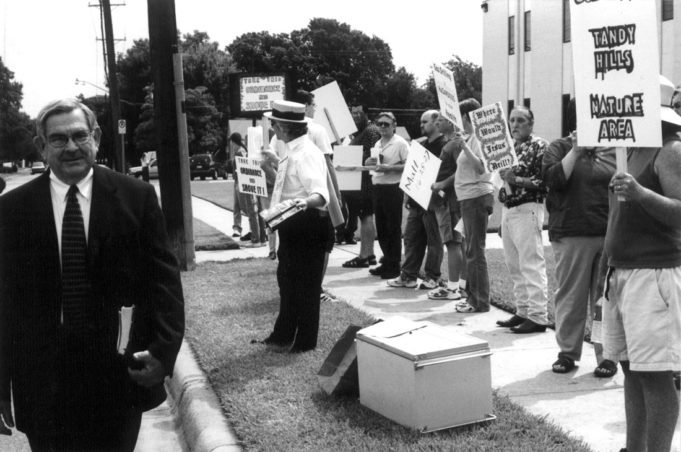In this corner! Weighing in at 10,000 pounds! Wearing a black mask and backed by a team of slick-haired lawyers! Give it up for … the petroleum industry!
And in the other corner! Weighing in at 90 pounds soaking wet! Wearing a hippie hairdo! Smelling of sassafras tea and wildflowers! It’s Don Young!
That’s how a ring announcer might have introduced the impending battle between a spindly, gray-haired tree hugger and the battalion of urban gas drillers that invaded Fort Worth in the early 2000s.
A bookie would have put the odds at 1,000 to 1 that Young and his smattering of environmentalists could defeat a ga-jillion-dollar behemoth that had spent the previous 100 years lobbying politicians to write laws on its behalf. Or, more accurately, lobbying politicians to pass laws mostly written by the industry folks themselves.
Making the battle even tougher for Young was the fact that Fort Worth voters in 2003 had elected Mike Moncrief as mayor. Moncrief cozied up tight with the drillers while viewing Young in the same manner that a hungry lion sizes up a baby gazelle.
So what a surprise that, 15 years later, Young remains standing with hardly a bruise. Urban drillers have thinned out. (Natural gas is selling today for about 1/10th of what it sold for in 2005.) Moncrief is long gone. And his successor, Betsy Price, was most recently heard singing Young’s praises during last week’s state of the city address.
Price used her highly watched address to announce the city’s desire to purchase slightly more than 50 acres of land known as Broadcast Hill and fold it into the adjacent 160-acre Tandy Hills Natural Area. What Price didn’t mention was that the 50 acres are considered ground zero – holy land – for Young’s revolution.
“This land is so rare, it’s like finding a unicorn,” Young said of Broadcast Hill. “You want to protect it. It is rugged country – more rugged than a lot of parts of Tandy Hills. No one ever goes over there. It’s probably where most of the wildlife hangs out.”
Fort Worth City Council was expected to approve the purchase during Tuesday night’s meeting but had not voted prior to press time.
If things had gone differently, the property might have been covered in gas wells and housing by now.
In the early 2000s, few people around here had heard of hydraulic fracturing – fracking. The process uses high-pressured liquid to fracture through underground rock to free natural gas. Fossil fuel proponents characterized it as clean energy.
At the time, the Fort Worth Star-Telegram turned full-blown public relations firm for the oil and gas industry, writing an embarrassing stream of one-sided business stories describing how beneficial drilling would be for the city. The paper’s fervor might have been amplified by the expensive full-page ads the drillers were purchasing in an era of falling revenues at newspapers.
At the Fort Worth Weekly, however, my colleagues and I were uncovering distressing information about air pollution, carcinogens, extreme water usage, and the bullying tactics that drillers relied on to steamroll their way to profits. In the spring of 2005, I wrote this newspaper’s first investigative story about gas drilling. I would write many more articles over the years before handing the beat to fellow reporter Peter Gorman.
After my first story appeared, Young called to introduce himself and invite me to a protest he was organizing at Sagamore Hill Baptist Church. Back then, the church owned the 50 acres next to Tandy Hills and was planning to sell it to Chesapeake Energy. Young grew up roaming those hills as a kid and bought a home nearby as an adult and devoted time and energy to keeping the place tidy. The thought of Chesapeake setting up gas rigs there and drilling next to and underneath Tandy Hills horrified him.
He put together a photo album of Tandy Hills wildflowers and visited the pastor at Sagamore Hill to plead with him to give Tandy Hills advocates a chance to make a counter offer. Young created the nonprofit Friends of Tandy Hills and solicited more than 50 letters from scientists, lawyers, educators, environmental groups, business leaders, and residents in support of protecting the land.
The protest at the church wasn’t a success technically since the church sold the property to Chesapeake. The incident, however, galvanized the activists, particularly Young.
“When the church sold the property to Chesapeake, I never expected the land to ever be available again,” Young said. “I shifted my attention to Tandy Hills land management, educational programs, and promotion and prayed it would not be fracked. Luckily, it did not get fracked.”
Other than Young and a smattering of environmentalists, few people paid much attention to Tandy Hills back then. Motorists passing by on I-30 might have wondered why the beautiful prairie land and rolling hills so close to downtown Fort Worth had never been developed. Young and his bunch promoted Tandy Hills as a biological wonderland, nature refuge, and recreational resource through events such as Prairie Fest, Kids on the Prairie, Manly Men Wild Women Hike, Trout Lily Walk, Brush Bash, PrairieSky / StarParty, the Tandy Hills BioBlitz, and others.
Friends of Tandy Hills left no doubt that they would fight year in and year out to discourage development or drilling near the park.
In 2015, Chesapeake listed the property for sale, and Young urged the city to buy and preserve it. Nothing happened. Later, the energy company Total took over Chesapeake’s assets, including the 50 acres, which were listed for sale at $700,000. Young, Jim Marshall, and other activists sweetened the stakes for the city by pledging more than $60,000 in private funding and sending hundreds of letters to City Hall. Assistant City Manager Dana Burghdoff said those private donations and broad support were “extremely helpful in making the case for acquisition.” The expected sale price is a reported $610,000.
The city’s turnabout was a pleasant shock to Young.
“What really amazes me is how quick this came about,” he said. “In only six weeks, the city went from nothing to owning the land we had been begging for since 2004.”
Another factor: The city commissioned a study a couple of years ago that showed the city needed more open space and parkland if they want to attract economic development.
Young remains willing to tangle with anyone causing harm to Tandy Hills, but, for now, the old fighter is enjoying a relaxing rest in a neutral corner.
“All these things came together, finally, to make me the happiest guy in town,” Young said.













Years ago, before anyone had heard of the Barnett Shale, Channel 5 donated this land to the church when they moved to Dallas. Having no need for such a large piece of land, the church put it up for sale.
A developer contracted with the church to purchase the land for residential development. But the NIMBYs would not hear of it because…I guess there was already plenty of new residential development on the east side?
So, even though the property had the proper zoning, the spineless politicians, faced with angry NIMBYs, denied the project. While the denial was legally sketchy, and probably could have been challenged in court, the developer went on his way.
Of course, had the residential development gone forward, there would not have been any land for the evil gas company to buy. But hey, I’m sure it’s a lot easier to get donations to save an urban prairie when you can point to the “threat” posed by the evil gas company right next door.
This whole thing is nothing more than government extortion. The city refuses to allow the property owner to do anything with his land. Finally, the property owner surrenders and sells the land to the city.